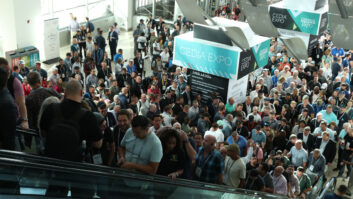Unlike Article II/Section 3 of the United States Constitution, which essentially requires the President of the U.S. to provide the a State of the Union address to Congress, there is no mandate for the consumer electronics industry to tell where things stand and where they are likely to go in the years ahead. The closest approximation that we have is the International CES. Like the Presidential address, I’d like to use CES to show how the technology and product promises of past shows have fared. Unlike the “real SOTU,” however, I’ll cover only one topic area here (video technology), leaving the Internet of Things, audio, and integration issues to the blogs of our distinguished RS colleagues.
4K/UHD and OLED
For those who might have previously compared 4K/UHD to 3D, let’s just say that the state of that union is solid and growing. While sets have been on sale for more than two years, all of the pieces were on view at CES to make 2016 the year where 4K/UHD becomes a “must have” rather than “nice to have.” To make the point with consumers that UHD is not just “more pixels,” but “better” pixels, virtually every brand from the traditional “Tier 1” legacy brands down to the upstart “Tier Three” brands added either OLED or quantum dot technology and 10-bit panels. Even more critical, the dramatic improvements in color palate provided by the widespread adoption of High Dynamic Range (HDR) clearly made the point that UHD is much more than a higher pixel count.

Looking more like a Roku or AppleTV than an UltraHD Blu-ray player, Philips’ UltraHD Blu-ray player will sport a second HDMI output for connection to legacy audio devices in addition to the main HDMI 2.0a/HDCP 2.2 jack.
Given the visible and underlying brand rivalries, it is to be expected that there were different approaches on how to implement all of this. That, in turn, requires some understanding on your team’s part to explain all of this to clients and prospects to validate the UHD proposition. There were two prominent HDR systems: the open “HDR10” standard, which embodies the SMPTE 2084/2085 standards; and Dolby Vision, which is a proprietary, licensed standard. At CES we saw sets with the latter from LG, TCL, Hisense, and for ex-U.S. sale only at this time, Changhong, joining the first Dolby Vision sets for Vizio. Where Dolby Vision is not mentioned in a display’s promotion, you’re almost certainly getting HDR10. Two other HDR proposals from Technicolor and Philips announced at CES that they are merging, but there were no sets available with that format.
Which is better? As with many things video, it is in “the eye of the beholder,” with each touting its own benefits. Note, however, that one does not live by HDR alone, and the implementation is as important here as the actual technology. To complicate things a bit more, the brightness for LCD sets differs from that of OLEDs. You pay your money and you take the choice that is best for the viewer. Whichever, the increased color rendition, a CIE space approaching or exceeding the cinema “P3” standard makes HDR a no-brainer.

The rear of this production-ready Samsung UltraHD Blu-ray player shows a second HDMI output for connection to legacy audio devices in addition to the main HDMI 2.0a/HDCP 2.2 jack.
New Formats, Branding
Rivalries abound at CES and the greater CE world, as they do in politics. In the latter, you find different groups within a party. At CES we found a confusing number of brand identities aimed at the same customer. Even more perplexing, many of the branding schemes sounded alike. Samsung started it last year with “SUHD.” This year we saw “Super UHD” from LG, “QUHD” from TCL, “ULED” from Hisense, and “QLED” from Changhong. If this confuses the knowledgeable among us, how can the consumer tell the difference?
Stepping into that void at CES was the UHD Alliance with its “Ultra HD Premium” standard specification. With variations for displays, UltraHD Blu-ray discs, content, and other aspects of the UHD ecosystem, the idea is to complement the branding of individual manufacturers to create a visible standard mark that is easily recognized to convey the message that the product carrying it meets a specific level of performance. While not having the Ultra HD Premium certification does not necessarily mean that a product is bad–none of the Sony UHD sets displayed at CES had it–having it does mean they are more than likely to be good.

Panasonic was among the many brands touting the new UltraHD Premium standard as a feature of their 4K/UHD displays, but Sony U.S. president Mike Fasulo (pictured, right) kept to a 4K/HDR logo for the moment.
To qualify, as TV must, of course, have 3840×2160 resolution, the ability to display at least 90 percent of the Digital Cinema Initiative’s P3 color space, support at least the baseline components of HDR10, measure a peak brightness of at least 1,000 nits (what you’ll find on LCD-based displays), or at least 540 nits of peak brightness, down to less than 0.0005 nits when black level is measured. Finally, there are two items that can, at a quick first glance, be misunderstood. The UltraHD Premium mark requires that a display be able to recognize and handle both 10-bit color and BT-2020 color.
Does that mean that these sets will be able to display those items? Certainly not yet for the latter, as there are no consumer flat panels that can show BT-2020 yet. Some sets will directly display 10-bit color, and most, but not all, will. We point this out to anyone scanning the standard with particular regard to BT-2020. Be careful to mention that the standard says that a set must know what to do with both inputs and display them as best it can, rather than just reject them. Different variations of this will be applied to 4K content, and that’s a good thing.

4K Content Options
There has been a bit of a dearth of titles and delivery systems to date, with streaming content or homebrew footage about the only choice. While broadcast and cable transmission of 4K native content are still a bit out in the distance, satellite and optical disc 4K content made great gains at this year’s CES.
To many attendees and pundits, the Hopper 3 from DISH was the hit of the show. It is amazing enough that this receiver/DVR has 16 HD-capable tuners. But even better, they may be combined so that the Hopper 3 can receive and display four simultaneous HD channels when connected to a 4K display. This “4K Sports Bar Mode” is certain to mean weekends huddled in the home theater for your sports-centric customers, as much as the availability of native 4K content from Netflix, Sony Pictures, and others will mean to movie buffs.


While the UltraHD Premium standard program set a level playing field at CES, many of the brands also adopted their own versions of “UHD” and “LED” designations for their own branding, as here with TCL’s QUHD.Skyworth joined LG and Samsung, among others, to show that while 8K isn’t quite here yet, it is possible and not that far over the horizon.
As noted, over-the-air transmission of 4K native content is not here yet, while the final parts of the ATSC 3.0 standard are being settled. The standard, however, is far enough along that both LG and Samsung showed live 4K content broadcast over local Las Vegas stations during CES. In the absence of the selection for the final audio standard, the demonstrations were video-only, but what we saw was spectacular. We’ll likely see–and hear–more on this at NAB in April.
Smart TVs and devices such as the Roku 4, TiVo Bolt, and Amazon FireTV, along with programming partners such as Netflix, M-Go, Amazon Prime, and Vudu have provided the lion’s share of 4K titles to date. While not unexpected, the formal announcement of UltraHD Blu-ray players and discs will complete the missing link for 4K content. Along with Philips and Panasonic, Samsung not only announced its player, but began taking orders for it at a surprisingly low price of $399 (same as the Philips price) on the first day of CES.


Samsung was among the many brands touting 1000 nits of brightness for its new UHD sets, thanks to quantum dot technology to meet the UHD Alliance standards.LG showed the future of superMHL as a possible connection point for 8K sets.
We don’t need to waste too much space on this one: If you don’t get one for any showroom display and suggest it to your existing UHD set-equipped clients, you will be missing a huge boat. For those concerned about the integration of UltraHD Blu-ray players in existing audio systems, we confirmed at CES that both the Samsung at Philips players will include a second, separate, “audio only” HDMI output for connection to audio devices with earlier versions of HDMI, along with the main HDMI 2.0/HDCP 2.2 outputs for connection to a similarly equipped AVR or surround processor on the way to the TV.
Related Video Technologies
As one would expect in a trade show that covered more than 2.4 million net square feet of exhibit space and included more than 3,600 exhibitors, there was more than I could cover in one article. I will delve into more topic-specific depth later in the year, just as the individual bills presented to Congress flesh out the broader SOTU presentation. But, we’d be remiss in not mentioning a few other video-related bits from CES 2016.

Live broadcasts to CES exhibits such as LG used a candidate version of the ATSC 3.0 standard to show that over-the-air 4K programming is getting closer to reality.
For installations where a projector is preferred, Texas Instruments showed its compact DLP components first previewed at CEDIA back in October. Making it possible to create large-screen, competitive brightness, and native 4K images, we expect this to be available in actual products by mid-year.
Elsewhere on the PTV front, the trend of compact, short-throw projectors continued not only with the many “pico projectors” seen in a variety of shapes and sizes, but Sony’s joining LG and Hisense shows that this may well be a viable and growing market category.


Magnavox showed a number of OTA DVRs at CES that should have high appeal to cord-cutters.
Moving back to direct-view displays, one of the most interesting things on exhibit was the “rollable” display shown by LG Displays. For clarity, this was in the demo space of the manufacturing arm of the giant Korean conglomerate, not the consumer products brand we’re more familiar with. We’ve seen this concept in rough form for a few years at scientific/academic trade shows. Seeing it during CES with vibrant color, and in a form that seems close to finished, makes it something to be on the lookout for much sooner than we might have otherwise expected.
As a counterpoint to the new, high-resolution, HDR world of today and tomorrow, two products we saw at CES reminded us that to some consumers, the past lives on. For clients who still have VHS cassettes that they want to watch or finally record over to DVD, the Philips brand was alone among the vast exhibit halls in showing a new model VHS/DVD recorder. With closets being cleaned out everywhere but with old-format content treasured for posterity, this is a unique item to consider.


There will be a great deal of information on UltraHD Blu-ray packaging to show off the possible options and connections.
Finally, with one foot in the over-the-air-TVreception past and another in the cord-cutter’s world of tomorrow, we saw a new range of off-air DVRs, from Magnavox. Sporting up to three OTA tuners and a 2 TB drive that can record up to 2,000 hours of HD programming, or in six-tuner/2 TB or two-tuner/1 TB models, they use Wi-Fi to send programming throughout the house from the main DVR, similar to how cable and satellite STBs do. I’ll be curious to see if this concept gets any traction.
In closing, the State of the Video Union is not only good, but it is expanding into new and exciting products that I hope will lead to economic prosperity for all. Even a President couldn’t ask for more than that.







